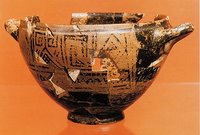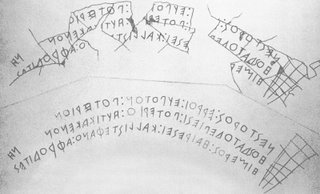Phallic Metre
kápṛn naraḥ kapṛthám úd dadhā́tana
codáyata khudáta vā́jasātaye
[Raise high the penis, o men, the phallus; drive (it), thrust (it) in, to win the prize.]
He scans these lines u-u-uuu-u-ux and -uuuuuu-u-ux, and points out that the string of short syllables in the second line is unusual for Vedic verse, and suggests that the final cadence -u-ux is "climactic". He parallels this with Greek metrics, viewing the five syllable -u-ux as a catalectic variant of the six syllable -u-u-x. It is interesting that this six syllable cadence in Greek was called ἰθυφαλλικόν, by virtue of its use in the Dionysiac φαλλαγωγία procession (the ritual from which Aristotle derives comedy, according to West, 1982). The song of the φαλλοφόροι, or phallus-bearers, is preserved in Athenaeus, and found in Watkins, translated by Campbell:
ἀνάγετ᾽, εὐρυχωρίαν
τῷ θεῷ ποιεῖτε·
θέλει γὰρ ὁ θεὸς ὀρθὸς ἐσφυδωμένος
διὰ μέσου βαδίζειν
[Stand back, make plenty of room for the god! For the god, erect and at bursting-point, wishes to pass through your midst.]
Watkins points out that lines 2 and 4 are ithyphallics, and line 3 is an iambic trimeter. He also notes that the first line, ἀνάγετ᾽, εὐρυχωρίαν, is metrically identical with kapṛthám úd dadhā́tana, which comes after the caesura in the first line quoted above from the Rig Veda. He finds it interesting that in Greek lyric, the ithyphallic almost always appears as the final element in its strophe, and suggests that it is, perhaps, a climactic cadence common to Indo-European poetics, or at least of the Greco-Aryan tradition.


